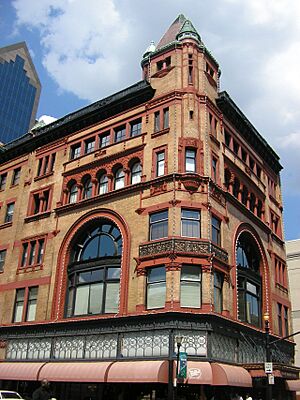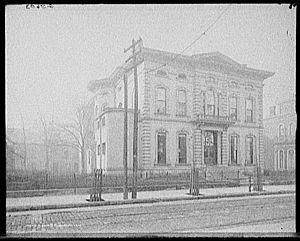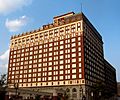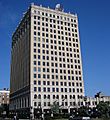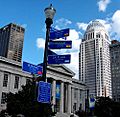Downtown Louisville facts for kids
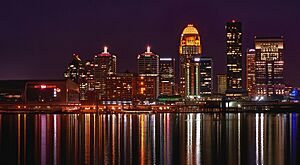
Downtown Louisville is the main city center in Louisville, Kentucky. It's the biggest business area in the state of Kentucky. Downtown Louisville is located by the Ohio River to the north, Hancock Street to the east, York and Jacob Streets to the south, and 9th Street to the west. In 2015, about 4,700 people lived there.
This important area is split into five main parts:
- West Main District: This is west of 2nd Street and north of Market Street.
- East Main District: This is east of 2nd Street and also north of Market Street. It includes the old Whiskey Row Historic District.
- Medical Center: This area has many hospitals and clinics.
- Fourth St. District: This is a lively area with shops and entertainment.
- Civic Center: This is where many government buildings are located.
Many of Kentucky's tallest buildings are in Downtown Louisville. These include 400 West Market, PNC Tower, PNC Plaza, and the Humana Building. Out of 16 buildings in Kentucky that are taller than 300 feet (91 meters), 12 are right here in Downtown Louisville! It's also the center for local and regional government.
There's a cool glass walkway called the Louie Link. It stretches for six city blocks and connects the Kentucky International Convention Center (KICC), Fourth Street Live!, and three hotels (Galt House Hotel & Suites, Marriott, and Hyatt Regency). This skywalk links up 2,300 hotel rooms. In 2010, it was made even longer to reach a new parking garage and the KFC Yum! Center.
Contents
History of Downtown Louisville
Downtown Louisville is the oldest part of the city. It grew up close to the Ohio River. The first big fort, Fort Nelson, was built in 1781 near what is now 7th and Main streets. Many early settlers lived around there.
Early maps of the city, like William Pope's plan from 1783, show a simple grid of streets along the river. Main, Market, and Jefferson streets still have their original names. Main Street was the city's main business area for almost 100 years.
By 1830, Louisville became Kentucky's largest city, with over 10,000 people. When steamboats became popular, the Louisville and Portland Canal opened just west of downtown. This helped local businesses grow even more. Most of Louisville's people lived downtown back then. Many old buildings still show what the area was like, with narrow, two- to four-story buildings close together.
The city kept growing during the railroad era. But with new trolleys, people started moving to areas like Phoenix Hill and Old Louisville. These areas were on the edges of downtown. Railroads also made the river less important for travel.
In 1886, the first skyscraper, the Kenyon Building, was built. Then came the ten-story Columbia Building in 1890. As electric streetcars arrived, people started moving to the suburbs. Some businesses followed them. But by the 1920s, the main shopping area was still downtown at 4th and Broadway. The riverfront also continued to improve, like with the building of the George Rogers Clark Memorial Bridge in 1929.
After World War II, more people moved to the suburbs. Downtown started to become less important. Since the 1970s, people have worked to make downtown better and save its historic buildings. Many new buildings have gone up.
Some old buildings were empty or falling apart. Many industrial sites by the river were left unused. Later, many of these areas were turned into Louisville Waterfront Park.
From the late 1970s to the early 1990s, nine new tall buildings were built downtown. These new buildings were closer to the river along Main and Market Streets.
Since 2000, downtown has grown a lot again. Not only are there new tall buildings, but more people are choosing to live and shop in the city center. The Louisville Slugger Field and a big expansion of Waterfront Park in 1998 helped start new growth. Old, empty blocks were rebuilt with new apartments and shops. Also, the 22,000-seat KFC Yum! Center was finished in 2010.
Living Downtown
In the early days, homes were built on lots sold to settlers. But these old wooden homes are gone now. What is now mostly offices and parking lots used to have many family homes on its edges until the early 1900s. Streets near Broadway had large mansions where business owners lived.
Even though these houses were made of brick, none are still single-family homes today. Some have been turned into offices. The Brennan House at 631 S. Fifth Street is a historic home that offers tours. It shows what downtown living was like in the past. One building at 432 South Fifth Street is the only home from before the Civil War still standing downtown. It was built in 1829 and is now used for businesses.
By the late 1900s, Downtown Louisville was known as a place to work during the week but not much happened on evenings or weekends. This started to change when old warehouses were turned into loft apartments in the late 1980s. By the late 1990s and early 2000s, new luxury apartments were built, like the 22-story Waterfront Park Place. This showed that more people wanted to live downtown. In 2013, work began on the second phase of RiverPark Place, a big apartment and condo project along River Road. In 1997, the Kentucky Towers was the biggest apartment building downtown. In 2015, The 800 Apartments also got a big update.
The number of homes available downtown was expected to double between 2005 and 2010. This is because of new apartment buildings and efforts to turn existing buildings into mixed-use spaces. For example, the historic eight-story Henry Clay building was redeveloped into homes, restaurants, shops, and event spaces.
Future Plans
There are many exciting projects planned for Downtown Louisville. These include building a new wharf along the Riverwalk Trail. Also, the Ohio River Bridges Project is making big changes to the "Spaghetti Junction" highway intersection (I-65, I-64, and I-71) and adding a new bridge for I-65 traffic going north. One project that is already finished is turning the old Big Four railroad bridge into a bridge just for walking and biking. It opened on the Kentucky side in 2013 and the Indiana side in 2014.
In 2007, city leaders announced a big plan called Center City. This plan aims to develop 23 acres (9.3 hectares) with new homes, restaurants, a movie theater, and a hotel. It would create about 500,000 square feet (46,451 square meters) of new space, including a 15-story building.
Another project announced in 2007 was the Iron Quarter, a shopping and office complex. It was planned for the Whiskey Row Historic District. This project was delayed, but later an agreement was made to save five of the seven historic buildings there. The fronts of all seven buildings are planned to be kept.
Fun Things to Do Downtown
Many fun places to visit are located in Downtown Louisville:
- "Museum Row" in the West Main District has several museums:
- East Market District has many art galleries, especially popular during the monthly First Friday Trolley Hop.
- Belle of Louisville (a historic steamboat)
- Early Times Distillery
- Fort Nelson Park
- Fourth Street Live! (an entertainment area)
- The Kentucky Center (for performing arts)
- Louisville Extreme Park (a skate park)
- Louisville Slugger Field (home of the Louisville Bats baseball team and Louisville City FC soccer team)
- Waterfront Park
- Riverfront Plaza/Belvedere
- KFC Yum! Center (home of the Louisville Cardinals basketball teams)
Images for kids
-
The Brown Hotel (built 1923)
-
Many of Louisville's skyscrapers, from left: The Humana Building, PNC Tower, LG&E Center (distant) and 400 West Market
-
400 West Market, Kentucky's tallest building since 1993



